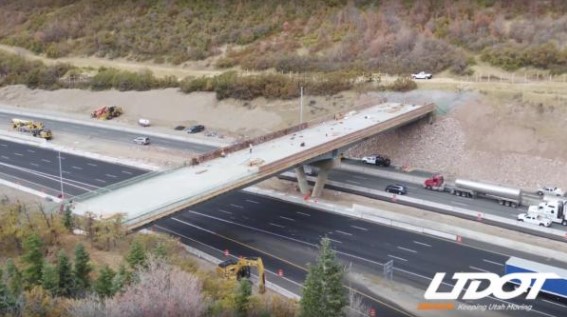Parleys Canyon Wildlife Bridge
Contents |
[edit] Introduction
A green bridge (also known as a wildlife crossing) allows the safe passage of wildlife over infrastructure such as railway lines and roads.
In December 2018, the Utah Department of Transportation (UDOT) announced plans for one of the largest wildlife overpasses in the United States. The structure was completed in 2019. It is 110 metres long, 15 metres wide and crosses six lanes of Interstate 80 (I-80). It is the second wildlife overpass in the state of Utah.
[edit] History
Funding for the Parley’s Canyon crossing came from a £3.7 million grant for the protection of migration paths for moose, elk, raccoons, deer and other native wildlife that might be displaced or endangered by the road.
The idea for the crossing was first proposed in 2016 by Save People Save Wildlife, an animal advocacy organisation. The UDOT worked with the Utah Division of Wildlife Resources to determine which part of the road might be most dangerous for wildlife. One particular area of the I-80 roadway (known as Slaughter Row) had a high number of animal/traffic collisions and this was selected as the most suitable spot for the wildlife overpass.
[edit] The planning process
The design project was undertaken by WSP USA on behalf of the Utah Department of Transportation (UDOT), the Utah Division of Wildlife Resources (DWR), Salt Lake City, Salt Lake County and Summit County. WSP provided structural engineering as well as support for civil and geotechnical engineering and landscape architecture.
The firm proposed three possible designs for the bridge: an asymmetric two-span bridge, an open-spandrel steel arch bridge and an anchored end span bridge. The asymmetrical two-span bridge was chosen.
Preliminary design began in January 2017, with construction starting in early 2018. The final landscape boulder was placed on the bridge during a December 2019 ceremony which marked the official opening. That was the last time people were permitted to walk across the overpass.
[edit] Special design considerations
Since it is used for wildlife rather than highway traffic, the bridge was constructed based on its ability to support the weight of snow. Consideration was given to the types of vegetation approaching the bridge, opting for landscape that resembles the surrounding habitat and angular rocks and logs that are common to the region. However it was difficult to anticipate whether or not animals would be willing to make the crossing over the noise and disturbance caused by the traffic below.
Wildlife fencing was installed along the highway corridor to prevent wildlife from entering the road and to 'train' animals to use the overpass.
[edit] First visitors
Original estimates anticipated a two- to three-year adjustment period before animals would begin to use the bridge. However, on 19 November 2020, the Utah Division of Wildlife Resources released a video that suggests the projections for adoption were too conservative. The video, posted on Facebook, captures moose, deer, black bears and elk using the bridge to cross the highway. A video taken at night shows a bobcat carrying another small mammal in its mouth. Another video shows a log being used as a scratching post by a big cat.
[edit] Related articles on Designing Buildings Wiki
- Biodiversity in building design and construction.
- Biophilia.
- Biophilic design.
- Bridge structures.
- Campaigning for biodiversity.
- Ecologist for building design and construction.
- Ecology connectivity.
- Green belt.
- Green infrastructure.
- Green roof.
- Green tunnel.
- Lights Out: Protecting migratory birds from illuminated skyscrapers.
- Spontaneous City at Cow Tower.
- The future of green infrastructure.
- Wildlife corridors.
[edit] External resources
Featured articles and news
RTPI leader to become new CIOB Chief Executive Officer
Dr Victoria Hills MRTPI, FICE to take over after Caroline Gumble’s departure.
Social and affordable housing, a long term plan for delivery
The “Delivering a Decade of Renewal for Social and Affordable Housing” strategy sets out future path.
A change to adoptive architecture
Effects of global weather warming on architectural detailing, material choice and human interaction.
The proposed publicly owned and backed subsidiary of Homes England, to facilitate new homes.
How big is the problem and what can we do to mitigate the effects?
Overheating guidance and tools for building designers
A number of cool guides to help with the heat.
The UK's Modern Industrial Strategy: A 10 year plan
Previous consultation criticism, current key elements and general support with some persisting reservations.
Building Safety Regulator reforms
New roles, new staff and a new fast track service pave the way for a single construction regulator.
Architectural Technologist CPDs and Communications
CIAT CPD… and how you can do it!
Cooling centres and cool spaces
Managing extreme heat in cities by directing the public to places for heat stress relief and water sources.
Winter gardens: A brief history and warm variations
Extending the season with glass in different forms and terms.
Restoring Great Yarmouth's Winter Gardens
Transforming one of the least sustainable constructions imaginable.
Construction Skills Mission Board launch sector drive
Newly formed government and industry collaboration set strategy for recruiting an additional 100,000 construction workers a year.
New Architects Code comes into effect in September 2025
ARB Architects Code of Conduct and Practice available with ongoing consultation regarding guidance.
Welsh Skills Body (Medr) launches ambitious plan
The new skills body brings together funding and regulation of tertiary education and research for the devolved nation.
Paul Gandy FCIOB announced as next CIOB President
Former Tilbury Douglas CEO takes helm.
UK Infrastructure: A 10 Year Strategy. In brief with reactions
With the National Infrastructure and Service Transformation Authority (NISTA).























